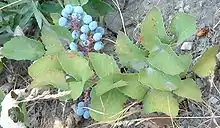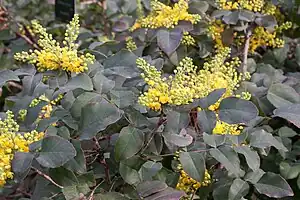| Creeping Oregon grape | |
|---|---|
 | |
| Berberis repens | |
| Scientific classification | |
| Kingdom: | Plantae |
| Clade: | Tracheophytes |
| Clade: | Angiosperms |
| Clade: | Eudicots |
| Order: | Ranunculales |
| Family: | Berberidaceae |
| Genus: | Berberis |
| Species: | B. repens |
| Binomial name | |
| Berberis repens | |
| Synonyms[1] | |
| |
Berberis repens commonly known as creeping mahonia, creeping Oregon grape, or creeping barberry, is a species of Berberis native to most of the western United States and two western provinces of Canada. It has found use as a xeric ornamental plant and has escaped from cultivation in areas beyond its native range.
Description
Berberis repens is an extremely short shrub, usually just 2–20 centimeters tall, very occasionally reaching 60 centimeters.[2] Berberis repens has conspicuous matte blue berries.[3] The yellow flowers appear in the middle of spring, and the blue berries in early summer. Although it is evergreen, in fall the leaves turn bronze. The plant is found at elevations from 300 metres (980 ft) to 2,740 metres (8,990 ft).[3]
Taxonomy
Some botanists place Berberis repens, and a significant portion of the barberry genus Berberis, in the genus Mahonia.[4] However, as of 2023 most botanical sources agree that it is properly placed in Berberis.[5][6][7][8] In this case, the scientific name may be given as Berberis repens. Additionally, some botanists treat the plant as a subspecies of Oregon-grape holly (Berberis aquifolium), in which case the scientific name Berberis aquifolium var. repens is applied.[3]
Names
Berberis repens is commonly known as "creeping mahonia",[9] "creeping barberry",[10] and "creeping Oregon grape".[11]
Distribution and habitat
It is native to the botanical continent of Northern America. In Canada its range is the southern parts of the provinces of Alberta and British Columbia.[12][13][14] In the United States it is found throughout the west from Washington (state) to California and eastwards to Montana to New Mexico including all the states between. East of the Rocky Mountains it is also found in the US states of Texas, North Dakota, South Dakota, Nebraska, and Minnesota.[4][1]
It has also been found as an introduced species in Ontario in Canada and Hungary in the European Union.[12][1]
It is widespread, and found at low to mid elevation on dry plateaus, in forests and on foothills.[11]
Uses
The berries are edible but are considered bitter,[11] and used to make jellies.[9][11]
The Tolowa and Karok Indians of Northwest California used the roots for a blood and cough tonic. The Hopi, Paiute, Navajo, Shoshoni, Blackfoot, Cheyenne, Mendocino, and other tribes also used the plant for medicinal, food, and ceremonial needs.[15] Native Americans also used the wood of the stem to produce yellow dyes[9] to stain woven baskets.[11]
Cultivation

Creeping mahonia is cultivated as an ornamental plant for use in natural landscaping, and in water conserving, drought tolerant, traditional residential, native plant habitat, and wildlife gardens.[9] It is a low water-needing ground cover for shade and brighter habitats, and in gardens under oaks to reduce or eliminate irrigation that can threaten mature Quercus trees. Berries and foliage are resistant to browsing by deer.
It is a year-round attractive, hardy plant, tolerant of drought, frost, and heat, so it is popular with landscape designers and gardeners. It can provide good ground cover in a cold situation. In garden conditions, and where their ranges overlap in nature, this species hybridizes readily with Oregon-grape (Mahonia aquifolium), and the hybrids are less prostrate in their habit than the pure stock.
References
- 1 2 3 "Berberis repens Lindl". Plants of the World Online. Royal Botanic Gardens, Kew. Retrieved 4 November 2023.
- ↑ Whittemore, Alan T. (5 November 2020). "Berberis repens - FNA". Flora of North America. Retrieved 4 November 2023.
- 1 2 3 "Jepson Manual treatment for BERBERIS aquifolium var. repens". Jepson Flora Project. University of California. Retrieved 1 January 2013.
- 1 2 Mahonia repens, USDA Natural Resources Conservation Service PLANTS Profile, 4 November 2023
- ↑ Flora of North America vol 3.
- ↑ Loconte, H., & J. R. Estes. 1989. Phylogenetic systematics of Berberidaceae and Ranunculales (Magnoliidae). Systematic Botany 14:565-579.
- ↑ Marroquín, Jorge S., & Joseph E. Laferrière. 1997. Transfer of specific and infraspecific taxa from Mahonia to Berberis. Journal of the Arizona-Nevada Academy of Science 30(1):53-55.
- ↑ Laferrière, Joseph E. 1997. Transfer of specific and infraspecific taxa from Mahonia to Berberis. Bot. Zhurn. 82(9):96-99.
- 1 2 3 4 "Mahonia repens". Plant Finder. Missouri Botanical Garden-Kemper Center for Home Gardening. Retrieved 1 January 2013.
- ↑ Ackerfield, Jennifer (2015). Flora of Colorado (1st ed.). Fort Worth: BRIT press. p. 201. ISBN 978-1-889878-45-4.
- 1 2 3 4 5 Neil L. Jennings Central Beauty: Wildflowers and Flowering Shrubs of the Southern Interior of British Columbia, p. 2, at Google Books
- 1 2 "Mahonia repens (Lindley) G. Don". Database of Vascular Plants of Canada (VASCAN). Canadensys. 14 September 2023. Retrieved 5 November 2023.
- ↑ "Mahonia repens (Lindl.) G.Don in GBIF Secretariat". GBIF Backbone Taxonomy. doi:10.15468/39omei. Retrieved 5 November 2023.
- ↑ "Taxon: Berberis repens Lindl". npgsweb.ars-grin.gov. Retrieved 22 October 2017.
- ↑ Moerman, Dan. "Mahonia repens". Native American Ethnobotany. University of Michigan-Dearborn. Retrieved 1 January 2013.
Other sources
- Beetle, A. A. Recommended plant names. Univ. Wyoming Agr. Exp. Sta. Res. J. 31. 1970 (Names Beetle)
- Correll, D. S. & M. C. Johnston Manual of the vascular plants of Texas. 1970 (F Tex)
- Erhardt, W. et al. Zander: Handwörterbuch der Pflanzennamen, 17. Auflage. 2002 (Zander ed17)
- FNA Editorial Committee Flora of North America. 1993- (F NAmer)
- Hickman, J. C., ed. The Jepson manual: higher plants of California. 1993 (F CalifJep)
- Hitchcock, C. L. et al. Vascular plants of the Pacific Northwest. 1955-1969 (F Pacif NW)
- Kearney, T. H. & R. H. Peebles Arizona flora, ed. 2. 1969 (F Ariz)
- Martin, W. C. & C. R. Hutchins A flora of New Mexico. 1980 (F New Mex)
- McGuffin, M., J. T. Kartesz, A. Y. Leung, & A. O. Tucker Herbs of commerce, ed. 2. 2000 (Herbs Commerce ed2)
- Welsh, S. L. et al. A Utah flora. Great Basin Naturalist Mem. 9. 1987 (F Utah)
